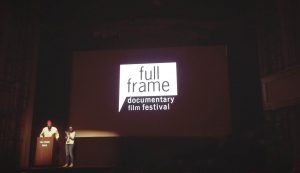
Filmmaker RaMell Ross screens “Hale County This Morning, This Evening”
This year’s Full Frame Documentary Film Festival was my first Full Frame experience, and I was not left wanting. I found myself among a community of filmmakers, generous and kind, and dedicated to telling powerful stories that move audiences. Each film I saw (a grand total of ten films) was eye-opening, captivating and elicited deep emotions as I sat mesmerized. The storytelling was complemented by skilled and aesthetically beautiful cinematography and editing. A true testament to the power of a well-made documentary are the questions asked of the filmmaker during the Q&A session after the screening. Viewers expressed a range of sentiments from “I had no idea that was happening” to “I want to make a change and how can I get involved?”
RBG, Generation Wealth, Minding the Gap, and Won’t You Be My Neighbor, to name a few, were riveting and inspiring. For me, however, there was one film that stood out above the rest: Hale County This Morning, This Evening. Now, full disclosure, I may have been biased because I’m from Alabama, the setting for this film. A visual poem, Hale County This Morning, This Evening, was easily one of the most captivating films I have seen in a while. Set in Hale County, Alabama, a rural town south of Tuscaloosa, Alabama, filmmaker RaMell Ross takes us through the days and nights of the lives of two young African American men, Quincy Bryant and Daniel Collins. Throughout the film we intimately experience Quincy’s and Daniel’s triumphs and joys, feeling their sufferings and sacrifices alongside them.
Filmed over a five-year period, Ross explored how black people are portrayed in film through a beautiful new powerful visual cinematic style, notably saying that “black people are not in control of images of ourselves. We’ve never been in control of images of ourselves.” Taking this reality into account, what the film accomplishes, not only visually but in story too, made it that much more powerful. By the end of the film I was left feeling connected to Quincy and Daniel, I felt admiration for their efforts and sadness for their losses. In the capable hands of Ross, we go to a place we may never have traveled to and are introduced to young men we may never have known. There is no whiff of the ‘aesthetics of poverty’ in this film. Instead, we are uplifted about the lives of a predominantly black community. We see them as Ross sees them. Beautiful. Human. Strong.
Finally, I’ll mention a little about the technical aspects of this film. The film was shot on a 5D Mark III Canon. You may recall, I mentioned this film was shot over five years. RaMell started editing the film about six months after he started filming both Quincy and Daniel. He also used time-lapse, associative editing and superimposition techniques to give the film its unique, almost ethereal style.
This film is a must see!
